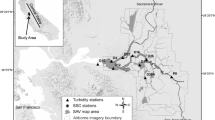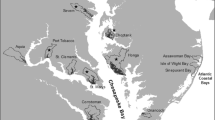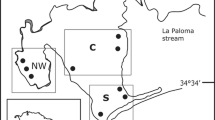Abstract
Links between hydrologic modifications, flow and salinity regimes, and submerged aquatic vegetation (SAV) species composition and abundance were assessed with an empirical analysis of 33 years of monitoring data collected at nine sites in Florida’s Caloosahatchee River Estuary (CRE). Freshwater inflows to the estuary (30-day means) were often outside the previously recommended envelope of 12.74 to 79.29 m3 s−1. Discharges from Lake Okeechobee through a synthetic hydrologic link were responsible for 43% of the above-envelope flows, but reduced the incidence of below-envelope flows by 30%. A salinity model and salinity stress indices developed for each SAV species indicated that the observed flows generated variable salinity conditions likely to harm both seagrasses and freshwater SAV in the estuary. Regression modeling of SAV abundance generally confirmed the flow and salinity responses expected for each species: Halodule wrightii and Thalassia testudinum in the lower estuary were both harmed by high-flow, low-salinity conditions, while Vallisneria americana in the upper estuary was decimated by low-flow, high-salinity conditions. There was a species-specific effect of the seasonal timing of high flows—T. testudinum was more negatively correlated with high flows in the dry season; H. wrightii in the wet season. The regression analyses also highlighted strong, year-to-year autocorrelations in SAV abundance, indicating reduced resilience after severe losses, particularly for V. americana. Large residual variation in some regression models suggested that factors other than salinity (e.g., optical water quality or grazing impacts) may also influence the system dynamics and should be incorporated in continuing research. This analysis suggests that use of artificial water management infrastructure to reduce extreme high and low flows to the Caloosahatchee and other estuaries could help maintain SAV health in light of intensifying climate variability and degraded watershed flow regulation capacity.





Similar content being viewed by others
References
Alber, M. 2002. A conceptual model of estuarine freshwater inflow management. Estuaries 25: 1246–1261.
Antonini, G.A., D.A. Fann, and P. Roat. 2002. A historical geography of Southwest Florida waterways. Vol. two. Placida Harbor to Marco Island: National Seagrant College Program.
Barnes, T. 2005. Caloosahatchee Estuary conceptual ecological model. Wetlands. 25: 884–897.
Barnes, T.K., A.K. Volety, K. Chartier, F.J. Mazzotti, and L. Pearlstein. 2007. A habitat suitability index model for the eastern oyster (Crassostrea virginica), a tool for restoration of the Caloosahatchee Estuary, Florida. Journal of Shellfish Research 26: 949–959.
Bartleson, R. 2010. Feasibility of Widgeon Grass restoration in the Caloosahatchee Estuary using exclosures. Report to West Coast Inland Navigation District through Lee County, FL, USA.
Bortone, S.A., and R.K. Turpin. 2000. Tape grass life history metrics associated with environmental variables in a controlled estuary. In Seagrasses monitoring, ecology, physiology and management. 318 pp, ed. S.A. Bortone, 65–79. Boca Raton: CRC Press.
Beck, M.W., J.D. Hagy, and C. Le. 2017. Quantifying seagrass light requirements using an algorithm to spatially resolve depth of colonization. Estuaries and Coasts 41: 592–601.
Burnham, K.P., and D.R. Anderson. 2002. Model selection and multimodel inference: A practical information-theoretic approach. 2nd ed. Springer.
Buzzelli, C., R. Robbins, P. Doering, Z. Chen, D. Sun, Y. Wan, B. Welch, and A. Schwarzschild. 2012. Monitoring and modeling of Syringodium filiforme (manatee grass) in Southern Indian River Lagoon. Estuaries and Coasts 35: 1401–1415.
Buzzelli, C., P.H. Doering, Y. Wan, and D. Sun. 2014. Modeling ecosystem processes with variable freshwater inflow to the Caloosahatchee River Estuary, Southwest Florida. II. Nutrient loading, submarine light, and seagrasses. Estuarine. Coastal and Shelf Science 151: 272–284.
Buzzelli, C., P. Gorman, P.H. Doering, Z. Chen, and Y. Wan. 2015. The application of oyster and seagrass models to evaluate alternative inflow scenarios related to Everglades restoration. Ecological Modelling 297: 154–170.
Cambridge, M.L., A.W. Chiffings, C. Brittan, L. Moore, and A.J. McComb. 1986. The loss of seagrass in Cockburn Sound, Western Australia. II. Possible causes of seagrass decline. Aquatic Botany 24: 269–285.
Ceilley, D.W., I. Bartozek, G. C. Buckner, M. J. Schuman. 2003. Tape grass (Vallisneria americana) restoration feasibility study. The Conservancy of Southwest Florida, Naples Florida. Final Report to the South Florida Water Management District. 11 pp.
Central and Southern Florida Flood Control District. 1954. Central and Southern Florida Flood Control Project: Five years of progress 1949-1954. West Palm Beach. https://www.amazon.com/Central-Southern-Florida-Control-Project/dp/1391494768.
Chamberlain, R.H., and P.H. Doering. 1998a. Freshwater inflow to the Caloosahatchee Estuary and the resource-based method for evaluation. In Proceedings of the 1997 Charlotte Harbor Public Conference and Technical Symposium. South Florida Water Management District and Charlotte Harbor National Estuary Program, Technical Report No. 98–02, ed. S.F. Treat, 81–90. Washington, D.C..
Chamberlain, R.H., and P.H. Doering. 1998b. Preliminary estimate of optimum freshwater inflow to the Caloosahatchee Estuary: A resource-based approach. In Proceedings of the 1997 Charlotte Harbor Public Conference and Technical Symposium. South Florida Water Management District and Charlotte Harbor National Estuary Program, Technical Report No. 98–02, ed. S.F. Treat, 121–130. Washington, D.C..
Doering, P.H., and R.H. Chamberlain. 2000. Experimental studies on the salinity tolerance of turtle grass, Thalassia testudinum. In Seagrasses: Monitoring, ecology, physiology, and management, ed. S.A. Bortone, 81–98. CRC Press LLC.
Doering, P.H., R.H. Chamberlain, and J.M. McMunigal. 2001. Effects of simulated saltwater intrusion on the growth and survival of wild celery, Vallisneria americana, from the Caloosahatchee Estuary (South Florida). Estuaries 24: 894–903.
Doering, P.H., R.H. Chamberlain, and D.E. Haunert. 2002. Using submerged aquatic vegetation to establish minimum and maximum freshwater inflows to the Caloosahatchee Estuary, Florida. Estuaries 25: 1343–1354.
Douglass, J.G., K.E. France, J.P. Richardson, and J.E. Duffy. 2010. Seasonal and interannual change in a Chesapeake Bay eelgrass community: Insights into biotic and abiotic control of community structure. Limnology and Oceanography 55: 1499–1520.
Douglass, J.G. 2014. Caloosahatchee River Estuary submerged aquatic vegetation. In Comprehensive everglades restoration plan, restoration coordination and verification, 2014 Systems Status Report, ed. South Florida Water Management District, 279–291. West Palm Beach. https://evergladesrestoration.gov/ssr/2014/ssr_full_2014.pdf.
Flaig, E.G., and J. Capece. 1998. Water use and runoff in the Caloosahatchee watershed. In Proceedings of the Charlotte Harbor Public Conference and Technical Symposium; 1997 March 15–16, Punta Gorda, Florida. Charlotte Harbor National Estuary Program Technical Report No. 98–02, ed. S.F. Treat, 73–80. West Palm Beach: South Florida Water Management District.
Fourqurean, J.W., and M.B. Robblee. 1999. Florida Bay: A history of recent ecological changes. Estuaries 22: 345–357.
Fourqurean, J.W., A. Willsie, C.D. Rose, and L.M. Rutten. 2001. Spatial and temporal pattern in seagrass community composition and productivity in South Florida. Marine Biology 138: 341–354.
Fourqurean, J.W., J.N. Boyer, M.J. Durako, L.N. Hefty, and B.J. Peterson. 2003. Forecasting responses of seagrass distributions to changing water quality using monitoring data. Ecological Applications 13: 474–489.
Frankovitch, T.A., D. Morrison, and J.W. Fourqurean. 2011. Benthic macrophyte distribution and abundance in estuarine mangrove lakes and estuaries: Relationships to environmental variables. Estuaries and Coasts 34: 20–31.
Frazer, T.K., S.K. Notestein, C.A. Jacoby, C.J. Littles, S.R. Keller, and R.A. Swett. 2006. Effects of storm-induced salinity changes on submersed aquatic vegetation in Kings Bay, Florida. Estuaries and Coasts 29: 943–953.
French, G.T., and K.A. Moore. 2003. Interactive effects of light and salinity stress on the growth, reproduction, and photosynthesis capabilities of Vallisneria americana (wild celery). Estuaries 26: 1255–1268.
Graham, W.D., M.J. Angelo, T.K. Frazer, P.C. Frederick, K.E. Havens, and K.R. Reddy. 2015. Options to reduce freshwater flows to the St. Lucie and Caloosahatchee estuaries and move more water from Lake Okeechobee to the Southern Everglades. Gainsville: Independent technical review by University of Florida Water Institute 143 pp.
Hauxwell, J., T.K. Frazer, and C.W. Osenberg. 2004. Grazing by manatees excludes both new and established wild celery transplants: Implications for restoration in Kings Bay, Fl, USA. Journal of Aquatic Plant Management 42: 49–53.
Hemminga, M. A., and C. M. Duarte. 2000. Seagrass ecology. New York: Cambridge University Press.
Herbert, D.A., W.B. Perry, B.J. Cosby, and J.W. Fourqurean. 2011. Projected reorganization of Florida bay seagrass communities in response to the increased freshwater inflow of Everglades restoration. Estuaries and Coasts 34: 973–992.
Herzka, S.Z., and K.H. Dunton. 1997. Seasonal photosynthetic patterns of the seagrass Thalassia testudinum in the western Gulf of Mexico. Marine Ecology: Progress Series 152: 103–117.
Hoffacker, V. A. 1994. Caloosahatchee River submerged grass observation during 1993. W. Dexter Bender and Associates, Inc. Letter-report and map to Chip Meriam, South Florida Water Management District.
Hopkinson, C.S., Jr., and J.H.J. Vallino. 1995. The relationships among man’s activities in watersheds and estuaries: A model of runoff effects on patterns of estuarine community metabolism. Estuaries. 18: 598–621.
Interagency Modeling Center. 2007. Spreadsheet model and water budget analysis for C-43 Project Delivery Team. Technical Memorandum MSR 262. 58 pp. U.S. Army Corps of Engineers and South Florida Water Management District. West Palm Beach, Florida.
Jarvis, J.C., and K.A. Moore. 2008. Influence of environmental factors on Vallisneria americana seed germination. Aquatic Botany 88: 283–294.
Johnson, M.W., K.L. Heck Jr., and J.W. Fourqurean. 2006. Nutrient content of seagrasses and epiphytes in the northern Gulf of Mexico: Evidence of phosphorus and nitrogen limitation. Aquatic Botany 85: 103–111.
Kraemer, G.P., R.H. Chamberlain, P.H. Doering, A.D. Steinman, and M.D. Hanisak. 1999. Physiological responses of Vallisneria americana transplants along a salinity gradient in the Caloosahatchee Estuary (SW Florida). Estuaries 22: 138–148.
Lapointe, B.E., D.A. Tomasko, and W.R. Matzie. 1994. Eutrophication and trophic state classification of seagrass communities in the Florida Keys. Bulletin of Marine Science 54: 696–717.
Light, S. S., and J. W. Dineen. 1994. Water control in the Everglades: A historical perspective. In Everglades: The ecosystem and its restoration, eds. SM Davis and JC Ogden. Delray Beach: St. Lucie Press.
Lirman, D., and W.P. Cropper Jr. 2003. The influence of salinity on seagrass growth, survivorship, and distribution within Biscayne Bay, Florida: Field, experimental, and modeling studies. Estuaries 26: 131–141.
Lirman, D., T. Thyberg, R. Santos, S. Schopmeyer, C. Drury, L. Collado-Vides, S. Bellmund, and J. Serafy. 2014. SAV communities of Western Biscayne Bay, Miami, Florida, USA: Human and natural drivers of seagrass and macroalgae abundance and distribution along a continuous shoreline. Estuaries and Coasts 37: 1243–1255.
Mazzotti, F.J., L.G. Pearlstine, R. Chamberlain, T. Barnes, K. Chartier, and D. DeAngelis. 2007a. Stressor response models for the seagrasses, Halodule wrightii and Thalassia testudinum. In JEM Technical Report. Final report to the South Florida Water Management District and the U.S..Geological Survey. Fort Lauderdale: University of Florida, Fort Lauderdale Research and Education Center.
Mazzotti, F.J., L.G. Pearlstine, R. Chamberlain, M.J. Hunt, T. Barnes, K. Chartier, and D. DeAngelis. 2007b. Stressor response model for tapegrass (Vallisneria americana). University of Florida CIR 1524.
Montagna, P.A., T. A. Palmer, and J. Beseres-Pollack. 2013. Hydrologic changes and estuarine dynamics. Springer Briefs in Environmental Science. https://doi.org/10.1007/978-1-4614-5833-3.
Montague, C.L., and J.A. Ley. 1993. A possible effect of salinity fluctuation on abundance of benthic vegetation and associated fauna in northeastern Florida Bay. Estuaries 16: 703–716.
Moore, K.A., E.C. Shields, and J.C. Jarvis. 2010. The role of habitat and herbivory on the restoration of tidal freshwater submerged aquatic vegetation populations. Restoration Ecology 18: 596–604.
Mote Marine Laboratory. 2007. Vallisneria americana restoration research in th Caloosahatchee River, Lee County, Florida. Mote Marine Laboratory Technical Report No. 1230. 10 pp. Sarasota: Mote Marine Laboratory.
National Academy of Sciences, Engineering and Medicine. 2017. Effective monitoring to evaluate ecological restoration in the Gulf of Mexico. Washington, DC: The National Academies Press.
Orth, R.J., T.J.B. Carruthers, W.C. Dennison, et al. 2006. A global crisis for seagrass ecosystems. Bioscience 56: 987–996.
Orth, R.J., M.R. Williams, S.R. Marion, D.J. Wilcox, T.J.B. Carruthers, K.A. Moore, W.M. Kemp, W.C. Dennison, N.B. Rybicki, P. Bergstrom, and R.A. Batiuk. 2010. Long-term trends in submersed aquatic vegetation (SAV) in Chesapeake Bay, USA, related to water quality. Estuaries and Coasts 33: 1144–1163.
Obeysekera, J., P. Trimble, C. Neidrauer, and L. Cadavid. 2007. Consideration of climate variability in water resources planning and operations — South Florida’s experience. World Environmental and Water Resources Congress 2007: 1–11.
Palmer, T.A., P.A. Montagna, R.H. Chamberlain, P.H. Doering, Y. Wan, K.M. Haunert, and D.J. Crean. 2015. Determining the effects of freshwater inflow on benthic macrofauna in the Caloosahatchee Estuary, Florida. Integrated Environmental Assessment and Management 12: 529–539.
Qiu, C., and Y. Wan. 2013. Time series modeling and prediction of salinity in the Caloosahatchee River Estuary. Water Resources Research 49: 5804–5816.
Rodriquez-Gallego, L., V. Sabaj, S. Masciadri, C. Kruk, R. Arocena, and D. Conde. 2015. Salinity as a major driver of submerged aquatic vegetation in coastal lagoons: A multi-year analysis in the subtropical Laguna de Rocha. Estuaries and Coasts 38: 451–465.
Rudolph, H. D. 1998. Freshwater discharges to the Lake Worth Lagoon – Recommendations for maximum and minimum discharges to maintain optimum salinity ranges for the Lake Worth Lagoon’s ecosystem. White Paper, Palm Beach County Department of Environmental Resources Management. West Palm Beach
SFWMD (South Florida Water Management District). 2003. Technical documentation to support development of minimum flows and levels for the Caloosahatchee River and estuary, status update report. May 2003.
SFWMD. 2014. Document to support a water reservation rule for the CERP Caloosahatchee River (C-43) West Basin Storage Reservoir. 63 pp. South Florida Water Management District. West Palm Beach Florida 57 pp.
Shields, E.C., K.A. Moore, and D.B. Parrish. 2012. Influence of salinity and light availability on abundance and distribution of tidal freshwater and oligohaline submersed aquatic vegetation. Estuaries and Coasts 35: 515–526.
Short, F.T., and S. Wyllie-Echeverria. 1996. Natural and human-induced disturbance of seagrasses. Environmental Conservation 23: 17–27.
Shuster, W.D., J. Bonita, H. Thurston, E. Warnemuende, and D.R. Smith. 2005. Impacts of impervious surface on watershed hydrology: A review. Urban Water Journal 2: 263–275.
USACE, and SFWMD. 2010. Central and southern Florida project Caloosahatchee River (C-43) West Basin storage reservoir project, final integrated project implementation report and final environmental impact statement. Jacksonville District and South Florida Water Management District: U.S. Army Corps of Engineers.
van Tussenbroek, B., M.G.B. Santos, J.K. van Dijk, S.N.M. Alcaraz, and M.L.T. Calderon. 2008. Selective elimination of rooted plants from a tropical seagrass bed in a back reef lagoon: A hypothesis tested by Hurricane Wilma (2005). Journal of Coastal Research 24: 278–281.
Wan, Y., C. Qiu, P. Doering, M. Ashton, D. Sun, and T. Coley. 2013. Modeling residence time with a three-dimensional hydrodynamic model: Linkage with chlorophyll a in a sub-tropical estuary. Ecological Modelling 268: 93–102.
Wan, Y., and K. Konyha. 2015. A simple hydrologic model for rapid prediction of runoff from ungauged coastal catchments. Journal of Hydrology 528: 571–583.
Waycott, B.M., C.M. Duarte, T.J.B. Carruthers, et al. 2009. Accelerating loss of seagrasses across the globe threatens coastal ecosystems. Proceedings of the National Academy of Sciences of the United States of America 106 (30): 12377–12381.
Worm, E.B., N. Barbier, N. Beaumont, et al. 2006. Impacts of biodiversity loss on ocean ecosystem services. Science 314: 787–790.
Zieman, J.C. and R.T. Zieman. 1989. The ecology of the seagrass meadows of the west coast of Florida: A community profile. U.S. Fish and Wildlife Service Biologial Report 85(7.25). 155 pp.
Acknowledgments
We thank the South Florida Water Management District’s Daniel Crean, Beth Orlando, Kathy Haunert, and Patricia Gorman for their significant efforts in study design, data collection and management, and project administration. Thanks are also due to the Sanibel Captiva Conservation Foundation’s Eric Milbrandt and Rick Bartleson for their contributions to study design and data gathering and for helpful discussions. The Coastal Watershed Institute at Florida Gulf Coast University provided invaluable logistical and administrative support. Judy Ott of the Charlotte Harbor National Estuary Program and Aswani Volety were instrumental in facilitating the cross-institutional discussions necessary for this effort. Numerous staff, students, and volunteers from all organizations involved assisted with this work over 33 years.
Funding
The work was supported by funding from the South Florida Water Management District.
Author information
Authors and Affiliations
Corresponding author
Ethics declarations
Disclaimer
The views expressed in this manuscript are those of the authors and do not necessarily reflect the views or policies of the U.S. Environmental Protection Agency, the South Florida Water Management District, or the St. Johns River Water Management District.
Additional information
Communicated by Masahiro Nakaoka
Rights and permissions
About this article
Cite this article
Douglass, J.G., Chamberlain, R.H., Wan, Y. et al. Submerged Vegetation Responses to Climate Variation and Altered Hydrology in a Subtropical Estuary: Interpreting 33 Years of Change. Estuaries and Coasts 43, 1406–1424 (2020). https://doi.org/10.1007/s12237-020-00721-4
Received:
Revised:
Accepted:
Published:
Issue Date:
DOI: https://doi.org/10.1007/s12237-020-00721-4




